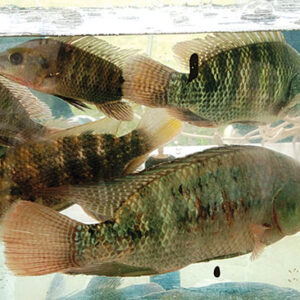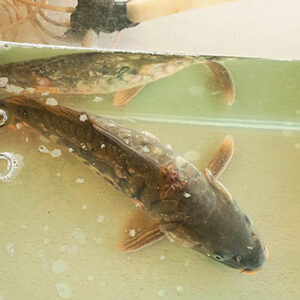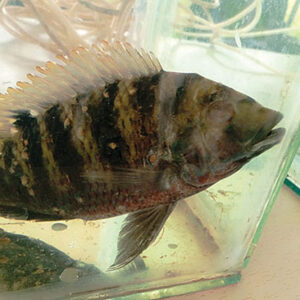
Features
Disease Management
Research
Ugandan agency develops herbal fish medicine
Researchers are developing an herbal antigen in the race to control bacterial pathogens threatening tilapia hatcheries.
February 15, 2024 By Bob Atwiine
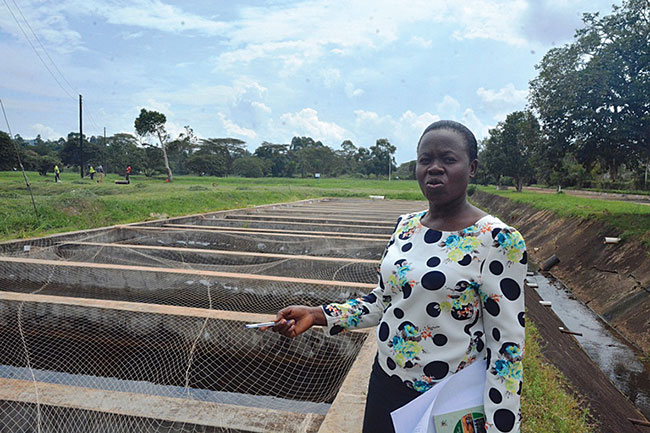 Catherine Agoe shows nursery ponds, where the herbal medicine was used to conduct tests at Aquaculture Research & Development Centre Kajjansi.
Catherine Agoe shows nursery ponds, where the herbal medicine was used to conduct tests at Aquaculture Research & Development Centre Kajjansi. Uganda is one of the countries in Africa where fish farming is on the rise, largely dominated by Nile tilapia and African catfish. Scientists in the fisheries sector say that fish diseases in the recent past were not a pressing issue for fish farming in Uganda. However, this may be masked by the low level of disease knowledge and awareness among fish farmers.
Due to the training conducted under donor-funded projects, like Smart project, aimed at advancing a certain strain of tilapia, the Ministry of Agriculture Animal Industry and Fisheries says it has been able to conduct awareness campaigns about the prevalence of fish diseases in the country. Under this campaign, fish farmers are now able to identify sick fish and can manage fish health.
Fish diseases in Uganda
According to researchers at the Aquaculture Research & Development Centre Kajjansi, common bacterial pathogens threatening fish in Ugandan hatcheries, ponds and cages include, Flavobacterium columnare, a causative agent of columnaris disease. It presents with skin lesions, fin erosion and gill necrosis, with a high degree of mortality, leading to severe economic losses in affected farms.
The researchers also identified another serious disease, Edwardsiella tarda, infecting both cultured and wild fish species in Uganda. Other diseases being studied are Saorole, Saprolegnia and Aeromonads.
Although the country is facing a challenge of bacterial pathogens and fungal infections, no viral diseases have been detected in fish farms, according to the Ugandan scientists.
Catherine Agoe, a research scientist at Aquaculture Research & Development Centre Kajjansi, says in fishes, there are a few cases which have specific signs and symptoms but notes that in general, fish diseases present the same signs and symptoms like ulcerations (wounds on the body), hemorrhage on the skin, and internal organs like liver.
Agoe adds that others present with bulging eyes, loss of appetite while in some situations fish like being at the pond inlets either for oxygen or the gills used for respiration have been damaged by the pathogen or the parasite.
Catherine Agoe explains that before treating fish, whenever approached by farmers, they always first dig up the history of what has been taking place inside the farms previously like grading, water quality parameters. It is from there that they advise farmers on what to do other than rushing to prescribe medications something she says has worked for very many fish farmers.
Herbal antigen
Although there is little challenge reported about fish disease in both wild and aquaculture fish, the burden of fish disease exists and scientists are inventing new innovations for treating the same.
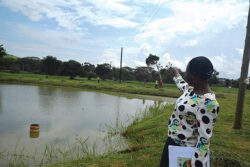
Earthen ponds where the fish are being reared for research
Scientists at the Aquaculture Research and Development Centre, Kajjansi, have developed an antigen from plants such as bidens pilosa (blackjack) to treat some diseases that attack fish.
Agoe told Hatchery International that some years ago, they identified that there were some common bacterial infections in fish farms across the country that were causing high fish mortalities.
“This prompted us into venturing into the use of plant extracts like herbal medicine to see how to mitigate the problem. Our focus was to see if the herbals promote growth because you know some herbs can treat and at the same time inhibit growth,” explains Agoe. “Our main emphasis was seeing if they promote growth in fish and boost immunity and that is using it as prevention and treating fish in case of disease occurrence.”
The researchers were able to conduct laboratory tests and on-farm trials against a particular pathogen and it worked very well.
The plant extract in both powder form is mixed in the fish feed and in liquid form which is used for bathing the fish. A mixture of water is used and the liquid extract where they can pour fish fingerlings for a specific period of time before they are poured into the pond.
Agoe reveals that for laboratory trials, 90 per cent of fish survived while on-farm trials registered 80 per cent. But, the fish that did not feed on the extract registered 100 per cent mortality rate.
“This helped us to make the conclusion that it was a specific concentration that promoted growth and boosted the immune system of the fish,” she said.
This antigen will be used in the treatment of Aeromonas hydrophila which was most prevalent at the time the research commenced in 2018.
“We isolated the pathogen using some of our international partner labs like Cefas lab in the U.K. and Virbac laboratories in France. We characterised the strain and subjected it to different plant extracts and it was a few plants that responded,” Agoe added.
Avoiding antibiotics
According to these researchers, the reason for using plants is because of its low or no residual effects on the ecosystem comparable to antibiotics.
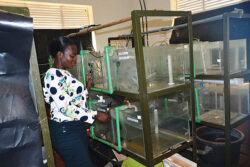
The Challenge Lab.
Agoe notes that however much a fish farmer may appropriately use antibiotics, with time, disease pathogens become resistant to them since living organisms evolve and change to new forms difficult to treat under different conditions.
Using antibiotics in ponds, cages and hatcheries to treat fish diseases is not allowed in Uganda. This is to prevent antibiotic residues used in cages and ponds from being washed away into Lake Victoria the home of the lucrative Nile perch and Nile tilapia which have high demand on the international market. The government is also concerned about the occurrence of micro-bacterial resistance if antibacterial drugs are used to treat fish.
In 2021, the Government of Uganda said an estimated 100 tonnes of Nile perch died mysteriously in a space of two months. The reason for the mass death of seemingly healthy fish remains unclear up to date raising fears of possible poisoning.
The massive death of the Nile perch has since created its scarcity on major fishing sites on Lake Victoria. The maw from the Ugandan Nile perch sells like gold in Hong Kong and Mainland China where it is used to manufacture other products.
Fish farmers are instead sensitized to use rock salt once they have disease outbreaks on the farms in addition to strict enforcement of biosecurity measures.
Fish health challenge
Scientists say fish health management in Uganda is still a big challenge and sometimes makes it difficult for the government to control disease outbreaks.
Agoe explains that sometimes, fish farmers sneak imported fish strains and brood stock undetected from countries where diseases are prevalent, which brings in new imported fish diseases.
“Fish health management is still a problem, however, through several donor-funded programs, we have been able to train fish farmers how to apply the best farming practices and how to control disease outbreaks on the farms, we are seeing some improvements.”
Biosecurity practices
The scientists contend that farmers must adopt best biosecurity measures and practices on their farms in order to reduce disease occurrence or reduce mortality rates.
When put together, these measures would constitute a holistic approach toward achieving a high level of biosecurity and disease outbreak control.
Agoe advised that farmers must ensure water quality before setting up fish farms saying that water is the most important limiting factor in the rearing of fish and directly affects feed efficiency, growth rate, the fish’s health, and survival.
Aquatic life is highly dependent on the physical, chemical, and biological factors of water, playing a substantial role in the biology and physiology of fish.
“Is the water a farmer going to use free from pollutants? Is it underground water? Is he going to degas it because those gases affect fish, once it is high in concentration with carbon dioxide, fish won’t be able to survive in that water?” Agoe posed.
She also advised farmers to construct parallel ponds with screened inlets to stop unwanted foreign materials, stock quality fish fingerlings by quarantining them for at least 14 days for disease checks before stocking into the pond.
Others include systematic and consistent routines for cleaning ponds, followed by disinfection of farm staff before accessing farms, and restricting visitors to the hatcheries to reduce carrying diseases.
Zoning by avoiding or reducing sharing input factors such as fish fingerlings, equipment, personnel, and water resources to minimize disease transmission.
Removing and destroying sick and dead fish to shed pathogens to the surroundings and continuous removal and adequate destruction of ensilage of the fish to reduce the overall infection pressure.
Following through an operation where an aquatic establishment is emptied of aquatic animals susceptible to a disease of concern or known to be able to transfer the pathogenic agent. Disease surveillance through a systematic series of investigations of a given population to detect and trace the occurrence of a disease for control purposes.
Print this page
Advertisement
- South Korean research explores reproductive cycle of farmed Pacific blue tuna
- FAO and Zimbabwe collaborate to boost fish breeding
